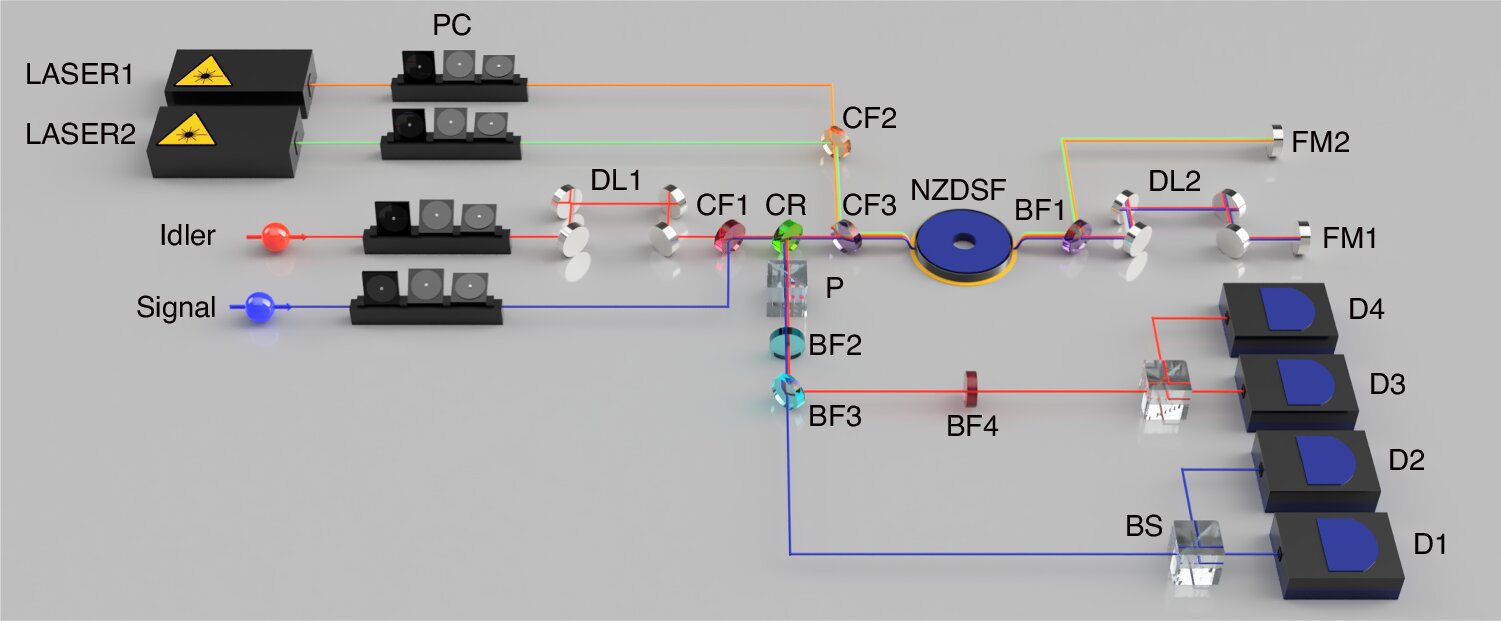NOON mode interference test setup. PC polarization controller, DL delay line, CF combinatorial filter, CR circulator, NZDSF nonzero dispersion fiber, BF bandpass filter, FM Faraday mirror, P polarizer, BS beam splitter, D superconducting nanowire single photon detector. Credit: Light: Science and Applications (2024). DOI: 10.1038/s41377-024-01439-9
x to close
NOON mode interference test setup. PC polarization controller, DL delay line, CF combinatorial filter, CR circulator, NZDSF nonzero dispersion fiber, BF bandpass filter, FM Faraday mirror, P polarizer, BS beam splitter, D superconducting nanowire single photon detector. Credit: Light: Science and Applications (2024). DOI: 10.1038/s41377-024-01439-9
Scientists have introduced a form of quantum entanglement known as frequency domain photon number path entanglement. This breakthrough in quantum physics includes an innovative tool called a frequency beam splitter, which has the unique ability to change the frequency of individual photons with a 50 percent success rate.
For many years, the scientific community has addressed space-domain path-photon number entanglement, a key player in the realm of quantum metrology and information science.
This concept involves photons arranged in a special pattern, called NOON modes, where they all lie in one or another path, and has applications such as super-resolution imaging that surpasses traditional limits, enhancing quantum sensors and developing It makes quantum possible. Computational algorithms designed for tasks that require exceptional phase sensitivity.
In a new article published in Light: Science and ApplicationsA team of scientists led by Professor Hideok Shin of the Department of Physics at Pohang University of Science and Technology in Korea has created entangled modes in the frequency domain, a concept similar to NOON’s space-domain modes but with a significant twist: instead. From the photons that are split between two paths, they are distributed between two frequencies.
This development has led to the successful creation of a two-photon NOON mode in a single-mode fiber, demonstrating the ability to perform two-photon interference with twice the resolution of its single-photon counterpart, demonstrating significant stability and potential for future applications. .
Experimental schematics for frequency domain interleaving. Two photons of distinct colors, red and blue, are injected into an interferometer built with two frequency beam splitters. Then the resulting interference pattern is measured. B, Interference pattern measured with the two-photon NOON mode, showing a two-fold increase in resolution compared to the single-photon counterpart. C, Interference pattern measured with single photon mode. Credit: Dongjin Lee, Wonchul Shin, Sebay Park, Junyeop Kim, and Hydeok Shin
x to close
Experimental schematics for frequency domain interleaving. Two photons of distinct colors, red and blue, are injected into an interferometer built with two frequency beam splitters. Then the resulting interference pattern is measured. B, interference pattern measured with the two-photon NOON mode, showing a two-fold increase in resolution compared to the single-photon counterpart. C, Interference pattern measured with single photon mode. Credit: Dongjin Lee, Wonchul Shin, Sebay Park, Junyeop Kim, and Hydeok Shin
Dongjin: “In our research, we change the concept of interference from occurring between two spatial paths to occurring between two different frequencies. This change allowed us to conduct both color components through a single-mode optical fiber and to create an unprecedented stable interferometer.” said Lee, first author of the paper.
This discovery not only enriches our understanding of the quantum world, but also paves the way for a new era in quantum information processing in the frequency domain. The discovery of frequency-domain entanglement represents promising advances in quantum technologies, potentially impacting everything from quantum sensing to secure communication networks.
more information:
Dongjin Lee et al., NOON mode interference in the frequency domain, Light: Science and Applications (2024). DOI: 10.1038/s41377-024-01439-9
Magazine information:
Light: Science and Applications
#Unveiling #quantum #frontier #frequency #domain #entanglement
